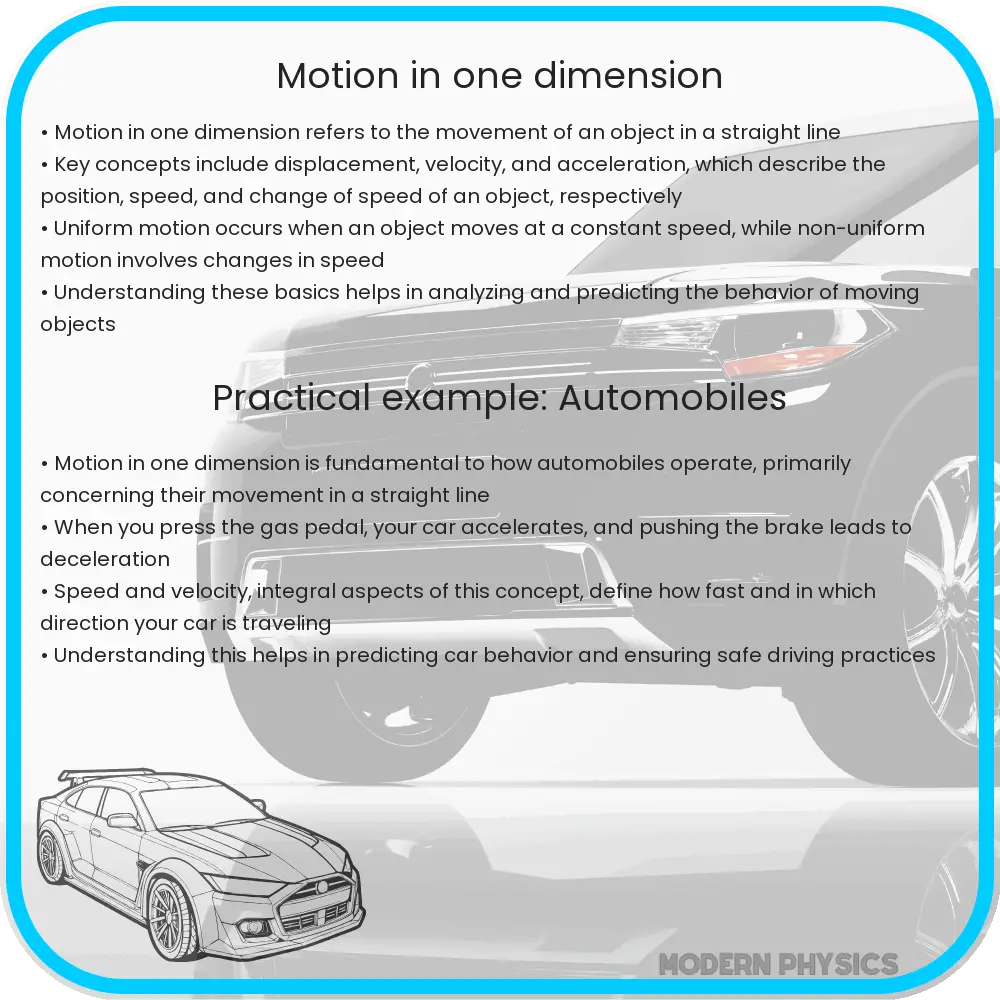Explore the essentials of one-dimensional motion, delving into velocity, acceleration, time, and kinematic equations in this comprehensive guide.

Motion in One Dimension: Understanding Velocity, Acceleration, and Time
Motion in one dimension is a fundamental concept in physics that delves into the movement of objects along a straight line. This type of motion is characterized by parameters such as velocity, acceleration, and time, each playing a pivotal role in understanding the dynamics of moving objects.
Velocity: The Speed and Direction of Motion
Velocity is a vector quantity that describes both the speed and direction of an object’s movement. It is often denoted as v and is calculated using the formula:
v = Δx / Δt
Where Δx represents the change in position and Δt denotes the change in time. The direction of velocity is determined by the direction of movement. For instance, if an object moves to the right, its velocity is positive, and if it moves to the left, its velocity is negative.
Acceleration: The Rate of Change of Velocity
Acceleration, denoted as a, is another vector quantity that describes the rate at which an object’s velocity changes over time. It is calculated using the formula:
a = Δv / Δt
Where Δv is the change in velocity, and Δt is the change in time. Acceleration can be caused by changes in speed, direction, or both. For example, an object speeding up has positive acceleration, while one slowing down has negative acceleration, often referred to as deceleration.
Time: The Duration of Motion
Time is a scalar quantity that represents the duration over which motion occurs. In physics, time is a crucial element in analyzing motion, allowing us to understand how long an object takes to move from one point to another. It is often represented by the symbol t.
Combining these concepts, we can analyze various aspects of one-dimensional motion. For example, we can determine how far a car travels if it accelerates at a constant rate over a certain period. The interplay of velocity, acceleration, and time forms the basis of kinematic equations, which are essential in solving problems related to motion in one dimension.
Kinematic Equations: The Tools for Analyzing Motion
Kinematic equations are mathematical formulas that provide a systematic approach to solving problems involving one-dimensional motion. They are particularly useful when two or more variables (position, velocity, acceleration, and time) are known, and others need to be found. The four key kinematic equations are:
- v = v0 + at
- x = x0 + v0t + ½at2
- v2 = v02 + 2a(x – x0)
- x = x0 + ½(v + v0)t
Where v is the final velocity, v0 is the initial velocity, a is the acceleration, x is the final position, x0 is the initial position, and t is the time. These equations are vital for solving various real-world problems, from calculating the landing spot of a thrown ball to determining the braking distance of a car.
Practical Applications of One-Dimensional Motion
Understanding motion in one dimension has numerous practical applications. In sports, athletes and coaches use concepts of velocity and acceleration to improve performance. In automotive safety, engineers calculate stopping distances and crash impacts. Even in the entertainment industry, animators and game designers use these principles to create realistic motion sequences.
Conclusion
The study of motion in one dimension is a foundational aspect of physics that provides a deep understanding of how objects move in our world. By mastering the concepts of velocity, acceleration, and time, and utilizing the kinematic equations, one can accurately describe and predict the motion of objects in a straight line. This knowledge not only enhances our understanding of the physical world but also has practical applications in various fields, from engineering to sports and entertainment. As we continue to explore the intricacies of motion, these fundamental concepts will remain crucial in the advancement of science and technology.
